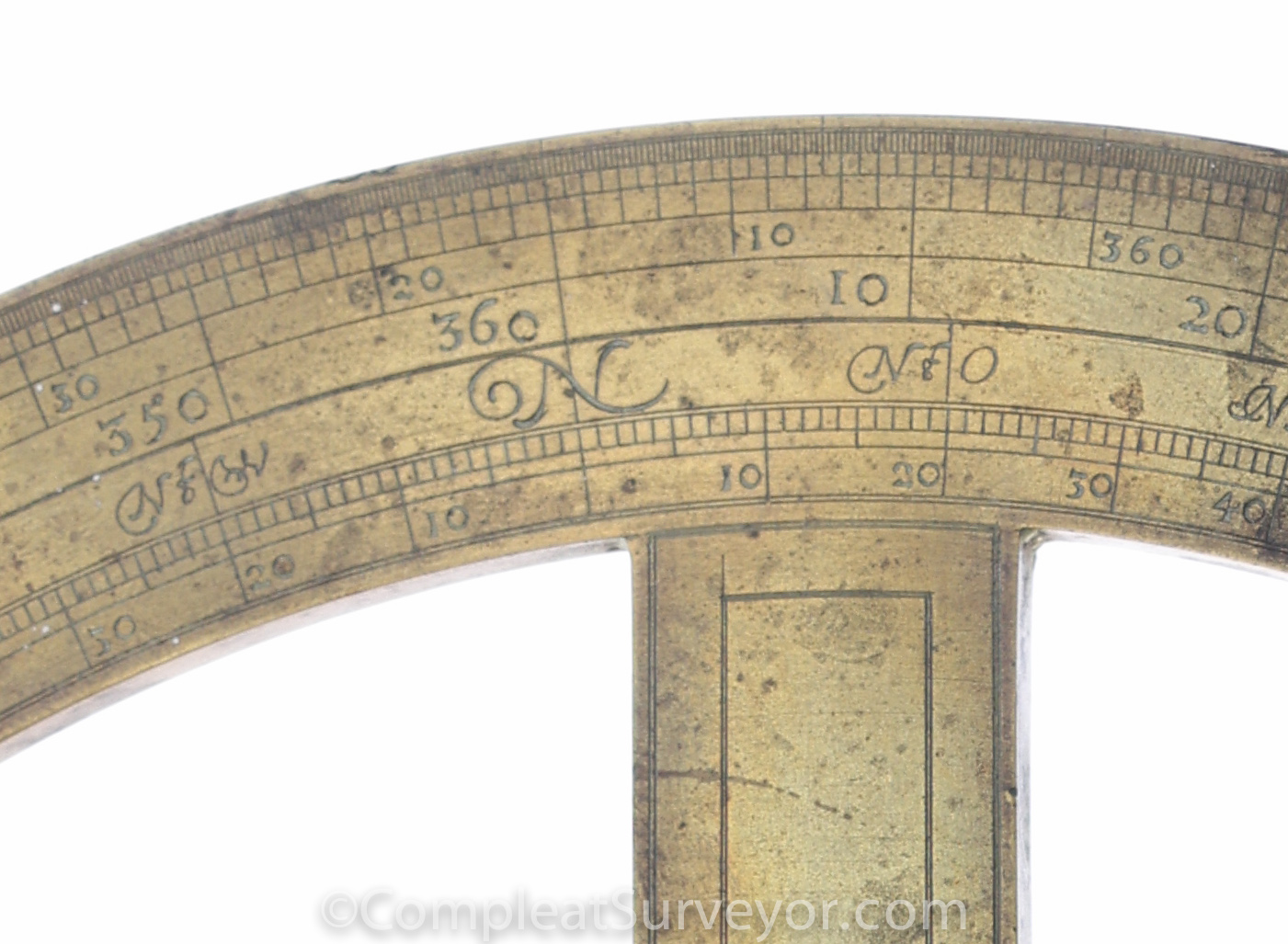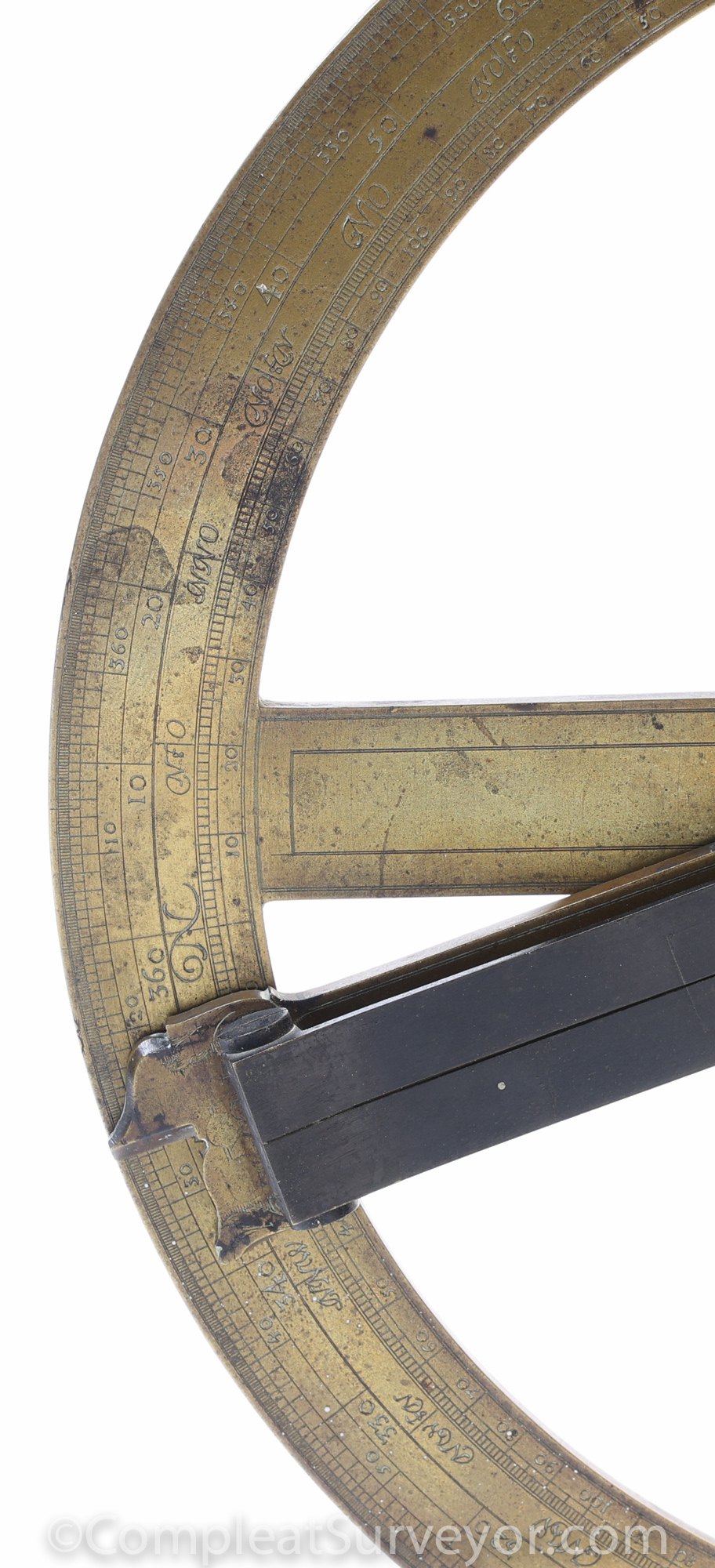
Franciscus Fiebig - About 1633 to 1647
It is believed that Franciscus Fiebig (aka Franziskus or Franz Viebig) made a variety of different instruments in Germany from roughly 1633 (in Arnstadt) to 1647 (in Haag), Unfortunately, there is not much known about Fiebig's life other than the instruments he left behind.
I found 4 Theodolites, 2 Graphometers, and a few other items made by Fiebig online and in published books. Some of these instrument show a very high skill level - like the illustration of the Theodolite at the top of this webpage.
There are a couple of noteworthy points to make about the Theodolites and Graphometers:
1. While it's hard to tell because most of the online and published photos lack enough resolution, it looks like Fiebig divided his instruments to 10 minutes of a degree (see pic immediately below). That's pretty impressive for the 1630s and 1640s time frame. I recall seeing one or more early Theodolites engraved to 15 minutes, and I might have another one engraved to 10 minutes, but I don't recall seeing anything engraved to less than 120 minutes in the 1600 to 1650 time frame.

2. Fiebig designed his Theodolites and Graphometers to hang vertically, so that they could read heights. The inner-most divided ring of his instruments have a tangent trigonometric scale of 0 to 100 to 0 in all 2 quadrants for Graphometers and in all 4 quadrants for Theodolites. These scales were evolved out of the 16th century Shadow Boxes seen on First Generation Theodolites. In a book published in 1616, Dou suggested that makers add trigonometric scales like this, and these scales were sometimes found on Second Generation Theodolites. A pretty cool feature.

3. Some of Firebig's instrument have a unique feature - the 360 degree divided rings are offset by 7.5 degrees. Instead of being set at 0 degrees, North is at 7.5 degrees, for example. Hmmm.
An 1890s German publication suggests that Fiebig used the 7.5 degree offset to account for the blockage created by the 4 fixed sights on the outside of the Theodolite. According to this publication, Fiebig's alidade was 15 degrees wide - double the 7.5 degree offset. So when the middle of the alidade was set exactly at the magnetic north pole, the left edge of the alidade was read 0 degrees on the 360 degree ring with the 7.5 degree offset.
Very nifty. Below is a pic showing a Fiebig Graphometer with the 7.5 degree offset. You can also see the offset in the pic at the top of the webpage - if you look on the left (West) side of the instrument, you will see the 360 degree mark on the middle divided ring 7.5 degrees to the left of center.

While that is a very nifty explanation, the Fiebig Theodolite I'm offering for sale suggests that the offset relates to declination and not to blocking sight vanes. My theodolite doesn't have fixed vanes, so the blocking issue doesn't exist (and hence no need for an offset under the German publications's theory). And unlike the other instruments, my Fiebig alidade uses the left edge of alidade to measure inner scales, and uses the middle of the alidade to measure the outer ring. And, finally, my Theodolite identifies where "N" is, while the other instruments do not identify a "N" point. (See pic below)
When my theodolite is set to the magnetic North, the left edge of my alidade rests on "N" and the middle of my alidade rests on 7.5 degrees West. I think the "N" on my theodolite stands for True North, not the magnetic north. My theodolite would be very confusing to use otherwise - the surveyor would always need to subtract 7.5 degrees from every calculation.
I suspect the other Fiebig instruments with the same 7.5 degree offsets were also designed to measure True North, and not Magnetic North.
Looking at historical variation data, the data is pretty murky. People didn't know that variation changed over time. But if you look at what people thought the declination was in 1600s German, I can see 7.5 degrees being a logical belief for a good part of Germany.


A Fiebig Graphometer - Might be in Moscow

A Fiebig Gunner's Level
© 2020 Russ Uzes/Contact Me

